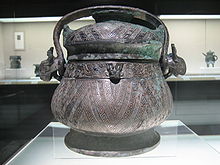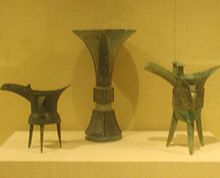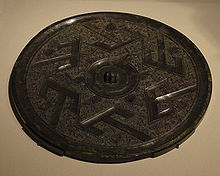- Chinese bronzes
-
Bronzes (simplified Chinese: 青铜器; traditional Chinese: 青銅器; pinyin: qīng tóng qì; Wade–Giles: ch'ing t'ong ch'i) are some of the most important pieces of Chinese art, warranting an entire separate catalogue in the Imperial art collections. The Chinese Bronze Age began in the Xia Dynasty, and bronze ritual containers form the bulk of the collection of Chinese antiques, reaching its zenith during the Zhou Dynasty. The appreciation, creation and collection of Chinese bronzes as pieces of art and not as ritual items began in the Song Dynasty and reached its zenith in the Qing Dynasty in the reign of the Qianlong emperor, whose massive collection is recorded in the catalogues known as the Xiqing gujian and the Xiqing jijian (西清繼鑑). Within those two catalogues, the bronzeware is categorized according to use:
- Sacrificial vessels (祭器),
- Wine vessels (酒器),
- Food vessels (食器),
- Water vessels (水器),
- Musical instruments (樂器),
- Weapons (兵器),
- Measuring containers (量器),
- Ancient money (錢幣), and
- Miscellaneous (雜器).
The most highly prized are generally the sacrificial and wine vessels, which form the majority of most collections. Often these vessels are elaborately decorated with Taotie patterns.
In China, the greatest part of discovered and preserved bronze items was not forged to ploughs or swords but cast to sacrificial vessels. Even a great part of weapons had a sacrificial meaning like daggers and axes that symbolized the heavenly power of the ruler. The strong religious sense of bronze objects brought up a great number of vessel types and shapes which became so typically that they should be copied as archaic style receptacles with other materials like wood, jade, ivory or even gold until the 20th century.
The ritual books of old China minutely describe who was allowed to use what kinds of sacrificial vessels and how much. The king of Zhou was favoured to use 9 dings and 8 gui vessels, a duke was allowed to use 7 dings and 6 guis, a baron could use 5 dings and 3 guis, a nobleman was allowed to use 3 dings and 2 guis.
Contents
Sacrificial vessels
- Dǐng (鼎) Sacrificial vessel (祭器), originally a cauldron for cooking and storing meat (食器). The Shang prototype has a round bowl, wider than it is tall, set on three legs (足); there are two short handles on each side (耳). Later examples became larger and larger and were considered a measure of power. It is considered the single most important class of Chinese bronzeware in terms of its cultural importance. There is a variation called a fāngdǐng (方鼎) which has a square bowl and four legs at each corner. There exist rare forms with lids. 西清古鑒 contains over two hundred examples, and this is the most highly regarded of all Chinese bronzes.
- Dòu (豆): Sacrificial vessel (祭器) that was originally a food vessel. Flat, covered bowl on a long stem.
- Fǔ (簠): Rectangular dish, triangular in verrtical cross-section. Always with a lid shaped like the dish.
- Zūn (尊 or 樽 or 鐏): Wine vessel and sacrificial vessel (器為盛酒亦祭用也). Tall cylindrical wine cup, with no handles or legs. The mouth is usually slightly broader than the body. In the late Zhōu (周) dynasty, this type of vessel became exceedingly elaborate, often taking the shape of animals and abandoning the traditional shape. These later types are distinguished from gōng (觥) by retaining a small, roughly circular mouth. This type of vessel forms the second largest group of objects in the Xiqing gujian, after the dǐng (鼎).
- Zǔ (俎): Flat rectangular platform with square legs at each corner. Not represented in the Xiqing gujian.
- Yí (彝): Sacrificial vessel. Two forms: A. Large squat round pot with two handles; B. Tall box-like container, the base narrower than the mouth with a roof-like lid. Later became a generic name for all sacrificial vessels.
Wine vessels
Two Jué on either side of a Gū, all from the Shang dynasty
- Gōng (觥, not pronounced guāng): Wine vessel often elongated and carved in the shape of an animal. There is always a cover and the mouth of the vessel usually covers the length of the vessel. This is not a classification used in the Xiqing gujian; objects of this type are classed under 匜.
- Gū (觚): Tall wine cup with no handles, the mouth larger than its base.
- Guǐ (簋): A cup with two handles.
- Hé (盉): A wine vessel shaped like a tea pot with three legs. It has a handle (pàn 鋬) and a straight spout that points diagonally upwards.
- Jiǎ (斝): A cauldron for warming wine. Like a dǐng (鼎) except the body is taller than it is broad, and it may have two sticks (柱) sticking straight up from the brim, acting as handles.
- Jué (角, not pronounced jiǎo): A wine cup similar to a 爵, except the spout and brim extension are identical and there is a cover.
- Jué (爵): A wine cup with three legs, a spout (流) with a pointed brim extension (尾) diametrically opposite, plus a handle (鋬).
- Léi (罍): Vessel for wine with a round body, a neck, a cover and a handle on either side of the mouth.
- Lì (鬲): Cauldron with three legs. Similar to a dǐng (鼎) except the legs blend into the body or have large swellings on top.
- Zhī (卮/巵/梔): Wine vessel, and also a measuring container. Like a píng (瓶), except shorter and broader.
- Zhōng (鍾): A wine vessel with no handles.
- Zūn (尊 or 樽 or 鐏): Wine vessel and sacrificial vessel (器為盛酒亦祭用也). Tall cylindrical wine cup, with no handles or legs. The mouth is usually slightly broader than the body. In the late Zhōu (周) dynasty, this type of vessel became exceedingly elaborate, often taking the shape of animals and abandoning the traditional shape. These later types are distinguished from gōng (觥) by retaining a small, roughly circular mouth. This type of vessel forms the second largest group of objects in the Xiqing gujian, after the dǐng (鼎).
Food vessels
- Duì (敦, not pronounced dūn): Spherical dish with a cover and three short legs.
- Pán (盤): Round curved dish for food. May have zero, three, or four short legs.
- Yǎn (甗): A pot for steaming. Three parts: 鬲, 甑, 箄 q.v.
- Yǒu (卣): Covered pot with a single looping handle attached on opposite sides of the mouth of the vessel.
- Zèng (甑): A rice pot; referred to as a 腹 fu4 in Xiqing gujian. Has no separate category in 西清古鑑: see yǎn (甗).
Water vessels
- Bù (瓿): see pǒu (瓿)
- Dǒu 斗: Scoop. Tall bowl with a long handle.
- Móu (鍪): A vase with two handles. Vessels of this type are classed as hú (壺) in the Xiqing gujian.
- Píng (瓶): Tall vase with a long slender neck opening up to a narrow mouth.
- Pǒu (瓿, pronounced bù in China): A small bronze wèng (甕).
- Wèng (瓮 or 甕): Round mouthed, round bellied jar with no foot for holding water or wine. Now commonly used to hold ashes.
- Yàndī (硯滴): Water container for an ink stone; often in the shape of an animal with a long thin dropper to control the amount of water dispensed.
- Yí (匜): A bowl with a spout; May be elaborately shaped like an animal.
- Yú (盂): Basin for water. May have up to four decorative handles around the edge; no brim.
- Zhì (觶): Broad-mouthed vase, similar in shape to a hú (壺), but with no handles.
- Zhōng (盅): Small cup with no handles. Not represented in Xiqing gujian.
Musical instruments
- Bó (鈸): Cymbals. Not represented in the Xiqing gujian. See náo (鐃).
- Gǔ (鼓): A drum.
- Líng (鈴): A small bell (as might be hung from ribbons). This item is not represented in Xiqing gujian.
- Náo (鐃): Cymbals. Not represented in Xiqing gujian. See also bó (鈸).
- Zhōng (鐘): A large bell, as might stand in a tower.
Weapons
- Duì (鐓, not pronouned dūn): Bronze decoration for the end of a spear or halberd handle; often with an animal motif.
- Jiàn (劍): A sword. There are only three examples in Xiqing gujian.
- Nǔjī (弩機): Crossbow mechanism. There are only two examples in the Xiqing gujian.
- Pī (鈹): A type of sword.
- Zú (鏃): An arrow head.
Measuring containers
- Zhī (卮 or 巵 or 梔): A wine vessel and also a measuring container. Like a píng (瓶), except shorter and broader.
Ancient money
- Bù (布) or bùwén (布文): Ancient money (錢幣). Rectangular with two legs and a head. Type of qián (錢)
- Fúyìnqián (符印錢): Taoist amulet minted in the shape of a yuán (圓), usually with an incantation on the obverse and picture on the reverse.
- Qián (錢): Ancient money (錢幣). Well represented in 西清古鑑; occurs in three types: 布, 刀, 圓(元) q.v.
- Yuán (圓): Also called yuánbì (圓幣), yuánbǎo (元寶), or yuánqián (元錢). Circular coins with a hole in the middle, usually made of copper or bronze; what most Westerners think of as 'Chinese money'. Also see fúyìnqián (符印錢).
Miscellaneous
- Biǎozuò (表座) Cylindrical container with added animal motif. There are only three examples in the Xiqing gujian.
- Jiàn (鑑 or 鑒): Refers to two different objects: either a tall, broad bronze dish for water, or a circular bronze mirror, usually with intricate ornamentation on the back. The modern meaning is a mirror.
- Jué (钁): Farming implement shaped like a pickaxe, but used as a hoe. 西清古鑑 contains only two examples; the rubric states: 按說文大鉏也又博雅斫謂之钁 "According to the Shouwen [an ancient Chinese dictionary] it is a large hoe, that is called a jué by the learned." Only the bronze heads of the two examples survive, because the wooden handles have long rotted away.
- Lú (鑪): A brazier. These are a nebulously classified group of bronze vessels and there are a number of forms: A. It may similar to a dǐng (鼎) with very short legs sitting on a pán (盤); or B., a duì (敦) on a pán (盤); or C., like a dòu (豆) on a pán (盤).
- Shūzhèn (書鎮): Paper weight. Usually solid bronze, moulded in the shape of a reclining or crouching animal (three recorded in Xiqing gujian).
Notes
References
- Xi'an Jiaqiang (in Chinese)
- Xiqing Gujian (西清古鑒). China. 1749–1755.
External links
- ritual vessels from AAT-Taiwan
Chinese bronzes Selected
vessel types
Other Categories:- Chinese bronzeware
- Chinese art
- Bronze Age in China
- Bronze Age art
Wikimedia Foundation. 2010.



